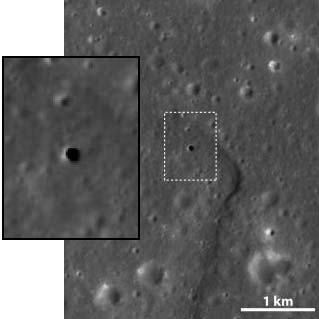Hole in the Moon Could Shelter Colonists

The moon may not be made of Swiss cheese, but it appears to have at least one deep hole, a vertical skylight that could serve as a protective lunar base for future astronauts.
"We discovered a vertical hole on the moon," an international team of scientists recently announced.
The gaping, dark pit on the near side of the moon is as big as a city block and deep as a modest skyscraper. It is thought to be a collapsed lava tube, created perhaps billions of years ago when the moon was warmer and volcanically active. The moon, overall, is more than 4 billion years old.
The discovery, detailed in the journal Geophysical Research Letters in October, was made using data from the moon-orbiting Japanese SELENE spacecraft. It was not widely reported at the time, and the journal announced it today. The work was led by Junichi Haruyama of the Japanese Space Agency JAXA.
Safe haven?
Recent discoveries of water and water ice on the moon hold promise that astronauts could journey back and stay for longer periods, perhaps even establish lunar colonies. But a remaining hurdle to setting up a permanent moon base is devising shelter to shield colonists from radiation and meteor strikes that befall the gray world, which has no protective atmosphere or magnetosphere.
"Because lava tubes are sheltered from the harsh environment on the moon's surface, such tubes could one day be useful for lunar bases," the scientists said in a statement.
Breaking space news, the latest updates on rocket launches, skywatching events and more!
Similar Mars caves have found and also envisioned as potential shelters, should humans desire to return to a sort of modernized cave man existence.
Deep and wide
The hole is nearly circular, about 213 feet (65 meters) across with a depth of 262 to 289 feet (80-88 meters). Here's how scientists think it was created:
Flowing lava long ago left a tunnel with a roof of somewhat fragile, cooled lava, which later collapsed. The hole is in the Marius Hills region, an area known to have been volcanic.
- Top 10 Amazing Moon Facts
- Moon Mechanics: What Really Makes Our World Go 'Round
- The Disappearing Moon: Why and Where it Hides
Join our Space Forums to keep talking space on the latest missions, night sky and more! And if you have a news tip, correction or comment, let us know at: community@space.com.

Rob has been producing internet content since the mid-1990s. He was a writer, editor and Director of Site Operations at Space.com starting in 1999. He served as Managing Editor of LiveScience since its launch in 2004. He then oversaw news operations for the Space.com's then-parent company TechMediaNetwork's growing suite of technology, science and business news sites. Prior to joining the company, Rob was an editor at The Star-Ledger in New Jersey. He has a journalism degree from Humboldt State University in California, is an author and also writes for Medium.
